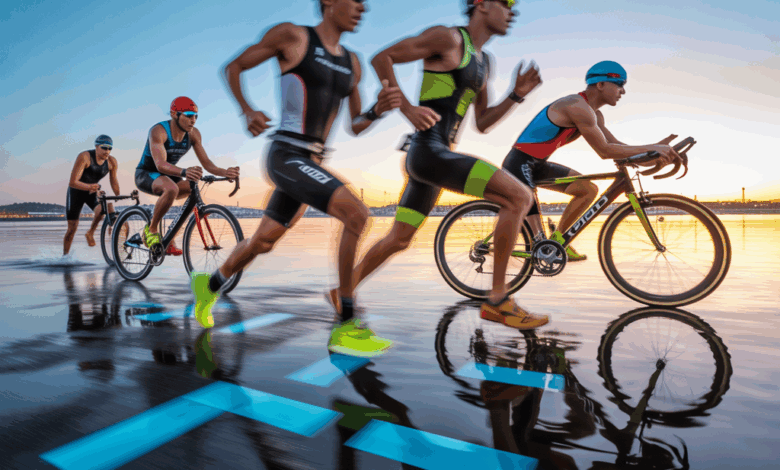Mission Bay Triathlon Guide — Your Complete Race-Day & Training Roadmap

Ever stood at the water’s edge wondering if you trained enough, if your transitions will be a disaster, or whether the bike course will eat your legs? If you’re picturing yourself crossing the finish line at Mission Bay with a smile (and maybe a little vomit of joy), this Mission Bay Triathlon guide will give you realistic training strategies, race-day tips, and lifestyle advice to get you there confidently.
Why choose the Mission Bay Triathlon?
Mission Bay in San Diego is famous for its calm, clear water, spectator-friendly course, and fast sprint-distance events that are perfect for beginners and age-group competitors alike. Whether you’re a first-timer doing your first sprint triathlon or a seasoned racer chasing a PR, the Mission Bay Triathlon offers a scenic, low-stress environment that rewards solid preparation.
Race overview — what to expect
Typical Mission Bay events are sprint-distance: a short open-water swim, a flat bike loop around the bay, and a run along beach paths. Expect:
- Open water swim in calm bay conditions — practice sighting and drafting.
- A mostly flat bike with technical turns — handling and cadence matter.
- A run with mixed surfaces — practice race-pace tempo runs and brick sessions.
Training plan essentials: Build fitness without burnout
Use this practical framework for 8–12 weeks depending on your base fitness. Prioritize consistency over volume.
Swim workouts and open water tips
- Technique focus: 2–3 pool sessions per week emphasizing drills — catch, rotation, and bilateral breathing.
- Open-water skills: once-a-week practice in a lake or bay for sighting, mass-start handling, and wetsuit feel.
- Sample set: 10-minute warm-up, 5 x 200m at threshold with 30s rest, 6 x 50m sprint, cool-down.
Bike sessions and handling
- Interval work: 1–2 sessions/week (e.g., 5 x 5 minutes at threshold with 3 minutes easy).
- Cadence drills and cornering practice: simulate Mission Bay turns in a safe area.
- Gear: tune your bike, wear snug clothing, and practice mounting/dismounting at race pace.
Run workouts and bricks
- Brick workouts: bike 20–40 minutes then run 10–20 minutes to adapt legs to the transition.
- Speed and tempo: 1 interval workout (e.g., 6 x 400m) and 1 tempo run (20–30 minutes at race effort) per week.
- Build volume slowly — increase weekly run time by no more than 10%.
Sample weekly microcycle (for intermediate athletes)
- Monday: Swim technique + mobility
- Tuesday: Bike intervals + short run (brick)
- Wednesday: Easy swim + strength training (core and posterior chain)
- Thursday: Tempo run + light bike recovery
- Friday: Rest or active recovery (yoga, easy swim)
- Saturday: Long bike with race-pace efforts
- Sunday: Open-water swim or long run
Race-day checklist and pacing strategy
Successful Mission Bay race days are about preparation and calm execution. Here’s a checklist and pacing plan to help you perform on the day.
Pre-race checklist
- Wetsuit (if allowed), goggles, swim cap, and anti-chafe balm.
- Bike in working order, helmet, sunglasses, and race wheels if you use them.
- Towel, socks, running shoes, bib belt, nutrition (gel or chews), and a small pump/CO2.
- Know the course, transition layout, and parking/arrival times.
Pacing tips
- Swim: stay relaxed for the first 200–300 meters, sight every 6–10 strokes, and draft when appropriate.
- Bike: aim for a steady threshold effort; avoid red-lining early through the turns.
- Run: start slightly conservative—your legs will feel heavy after the bike. Build to race pace in the second half.
Nutrition, recovery, and lifestyle habits
Training is only part of the equation. Fueling, sleeping, and recovery habits make the gains stick.
Daily nutrition basics
- Prioritize whole foods: lean protein, complex carbs, healthy fats, and lots of vegetables.
- Pre-workout: a small carb snack 30–60 minutes before hard sessions (banana, toast).
- Post-workout: aim for a 3:1 carb-to-protein ratio within 30–60 minutes to optimize recovery.
- Race nutrition: test gels and hydration strategy in training; don’t try new products on race day.
Recovery tips
- Sleep: aim for 7–9 hours nightly to support adaptation.
- Active recovery: easy swims, walks, or mobility work help reduce soreness.
- Strength training: 1–2 sessions/week to build durability and reduce injury risk.
Gear and logistics: what to bring to Mission Bay
Pack light but smart. Having these items organized will reduce pre-race stress:
- Transition mat or towel, race belt, safety pins.
- Spare tube, multi-tool, pump, and CO2/patch kit.
- Sunscreen, hat, warm layers for pre-race, and post-race recovery snack.
Real-world example: A beginner’s success story
Anna, a 36-year-old teacher, started with six weeks of focused training—three swims, two bikes, two runs, and one strength session per week. She focused on open-water practice and two brick workouts. On race day at Mission Bay she executed controlled pacing, nailed transitions with a practiced layout, and finished smiling under her goal time. Her secret? Consistency, realistic goals, and practicing race-day logistics ahead of time.
Mission Bay Triathlon guide: final race prep checklist
- Confirm registration and race packet pickup times.
- Lay out transition gear the night before; pin your bib to a belt.
- Warm up with light mobility and a short swim if possible.
- Stick to tested nutrition and pacing strategies.
Frequently Asked Questions
Q: What distance is the Mission Bay Triathlon?
A: Most Mission Bay events are sprint distance (typically around a 400–750m swim, 10–20 km bike, and 2.5–5 km run). Distances can vary by event—check the specific race details when you register.
Q: How do I prepare for open water at Mission Bay?
A: Practice sighting, bilateral breathing, and mass-start simulations in open water. Do at least one swim per week in similar conditions and practice with your wetsuit and race goggles beforehand.
Q: Any tips for faster transitions?
A: Create a checklist and practice transitions as a timed drill. Arrange your gear the same way each time: shoes, helmet, bib, nutrition. Use elastic laces for quick shoe entry and rehearse mounting/dismounting the bike.
Conclusion — Take the next step toward your best Mission Bay day
This Mission Bay Triathlon guide gives you the blueprint: targeted swim, bike, and run workouts, realistic race-day strategies, and lifestyle advice to arrive fit and calm. Ready to train smarter? Start by building a consistent weekly plan, practice transitions, and refine your nutrition. If you want more specific training templates, check out our workout routines and fuel your training with tips from our nutrition guides. For recovery and mental prep, explore our wellness tips.
Sign up for a local open-water practice, lay out your race bag tonight, and commit to one focused session this week — your Mission Bay finish line is closer than you think.





